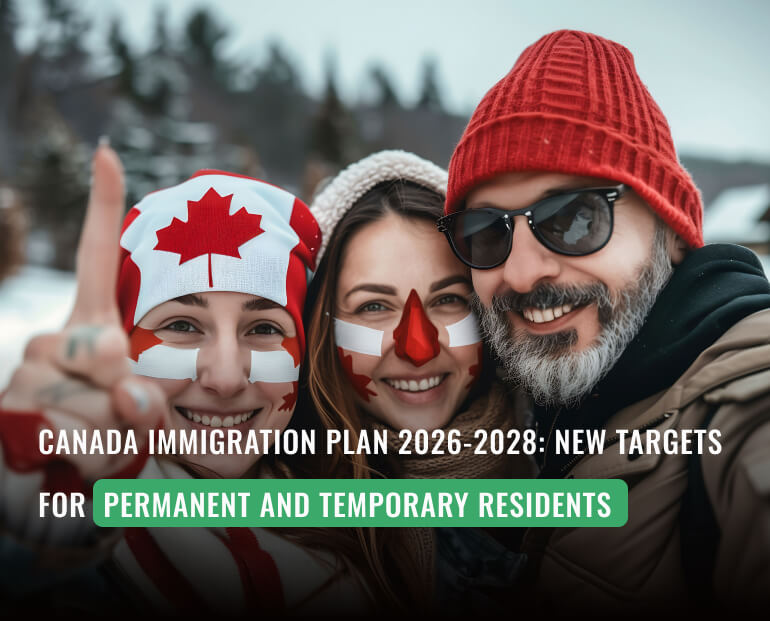The Canadian federal government introduced its new immigration targets for 2026-2028 with the clear intention of maintaining the number of permanent admissions at a steady level while reducing temporary entries.
The program maintains the number of permanent resident targets at 380,000 per year (a decrease from 395,000 in 2025) and changes the proportion of the economic migrants.
On the other hand, the number of temporary residents (the holders of work, study permits, etc.) will be drastically reduced – from 673,650 approximately in 2025 to 385,000 in 2026 and 370,000 in both 2027 and 2028.
The alterations are designed to lessen the pressure on housing, the health sector, and schools and at the same time, correspond to labor needs. It is planned that certain long-term temporary residents, such as those holding work permits and protected refugees, will be given quicker access to permanent status (TR→PR) through newly introduced measures.
If you are struggling to get a Canadian visa from India, DM Consultants is the right place to help you. We evaluate your skills and education, find the best skilled-worker option for you, and complete your skilled-worker visa and work-permit application on time and in compliance with the regulations.
Key Highlights of the 2026–2028 Plan
Canada’s new levels plan summarizes the big objectives and changes in one document. To put it simply, the plan maintains the level of permanent immigration and decreases the number of temporary immigrants.
The essential points are as follows:
- Admission targets: 380,000 new immigrants per year (2026–2028) – no change, decreased from 395,000 in 2025.
- Economic focus: The proportion of the economic-class immigrants increases to ~64% of the total (from 59%). More spots are provided both for the skilled and business streams (PNPs, high-skilled workers).
- Temporary caps: The caps are lowered to 385,000 (2026) and 370,000 (2027–28), a decrease of around 43% from 673,650 in 2025. The impact of these decisions is the reduction of newcomers in foreign worker and study categories.
- Student reduction: The number of Study permits drops to about 155,000 in 2026 (compared to 305,900 in 2025) – a reduction of approximately 50%.
- Worker decrease: The number of new work permits will be 230,000 in 2026 (a decrease from 367,750 in 2025), then 220,000 in 2027–28 (a reduction of around 37%). The focus of the work will be on higher-skilled and in-demand roles.
- Pathway creation: Few special projects will convert up to 33,000 work-permit holders to permanent residents (2026–27), and over the same period, approximately 115,000 eligible protected persons (refugees/claimants) will be recognized as permanent residents.
- French speakers: The percentage of French-speaking immigrants outside Quebec will increase to around 10–10.5% by 2028 (approximately 30–35 thousand annually) to help French-speaking communities.
- Industry support: The plan provides support for the industries that have been affected by tariffs and for the remote and rural areas. Furthermore, it tightens the regulations for low-wage work permits and encourages high-skill immigration.
Admissions for Temporary Residents (2026–2028)
The new plan cuts the number of temporary visas given out each year by a lot. This includes non-permanent visas for foreign students, guest workers, and others. In recent years, the number of visitors, students, and workers has grown quickly, putting a strain on local housing and services.
The people who wrote the plan say that these limits will lower the number of temporary residents in Canada to less than 5% of the population by 2027.
Right now, it’s around 6–7%. The goal is to slow down new temporary arrivals until housing, health care, and schools can catch up.
These lower caps mean that there will be a lot fewer international students and standard work permits. The goal is to have a more “controlled” intake that fits with the current capacity. Here is a list of the goals for the year:
| Year | Total Temporary Residents | Work Permits | Study Permits |
| 2025 (target) | 673,650 | 367,750 | 305,900 |
| 2026 | 385,000 | 230,000 | 155,000 |
| 2027 | 370,000 | 220,000 | 150,000 |
| 2028 | 370,000 | 220,000 | 150,000 |
Are you swamped with forms, proofs, and credential checks? DM Consultant looks over your papers, help you show off your education and skills, and write a clean, error-free application to make it more likely that you will get Canadian skilled immigration.
Admissions for Permanent Residents (2026–2028)
The plan, on the other hand, keeps the number of permanent residents (PRs) coming in at 380,000 per year. That goal stays the same from 2026 to 2028. The goal is for the permanent population to grow steadily (by less than 1% per year) so that Canada can welcome new people.
Of these 380,000 spots, about 64% go to economic-class immigrants in the main plan (up from 59%). The rest is divided between family reunification and humanitarian classes, with small decreases planned.
Important parts of the PR mix are:
- Economic class: Most spots (about 240,000 in 2026, with a small rise after that) go to skilled workers, business migrants, and provincial nominees. Their PNPs give provinces a bigger share.
- Family reunification: In 2026, there will be about 84,000 spouses, partners, parents, and children of citizens and permanent residents. This is a small drop from previous years.
- Humanitarian admissions: In 2026, there will be about 56,200 places for refugees, protected people, and other humanitarian cases. (This is down from about 62,000 before.)
- French target: About 9–10% of all PR admissions will be French-speaking newcomers from outside Quebec. By 2028, this will be about 10.5% (about 35,000), up from 9% in 2026.
Changing Temporary Residents to Permanent Residents
A big part of the plan is to make it easy for long-term temporary residents to stay. It recognizes that many foreign workers, students, and refugees who are already living in Canada have made lives here.
The government announced two one-time programs (over 2026–2027) to make the system easier and use this talent:
- Work permit pathway: Up to 33,000 people with valid work permits will be given priority for permanent residency. These are usually people who have skilled jobs, a long history of working in Canada, and jobs that are in high demand. The goal is to “honor workers who have put down roots, pay taxes, and help the economy.”
- Refugee integration: About 115,000 people who are eligible for protection, like convention refugees and other refugee claimants in Canada, will get permanent resident status over the next two years. This step helps people who can’t go back home and have been living in Canada temporarily.
More steps related to TR→PR are:
- Permit bridging: Like in previous years, people who apply for PR from inside Canada can get an open work permit to keep working legally while they wait. (The government has said that it will probably keep giving these bridging permits to people who meet the requirements.)
- Application speed: The plan suggests that some applications from workers and family sponsors will be given more priority and processed faster (with extra money for IRCC).
- Skill priority: The plan indirectly helps keep skilled immigrants (like engineers and scientists who are already here) by moving a lot of work permits to economic PR.
The government is counting on immigration that comes from within the country. It won’t bring in more workers from other countries; instead, it will settle many who are already working in Canada.
Conclusion
Canada’s immigration plan for 2026–2028 is a clear change from the huge growth in temporary visas that has happened in the past. It will be steadier and balanced.
The new temporary-to-permanent residency programs show that Canada values the work of people who are already there and wants to keep them there.
Need help from India at every turn? We help you get ready to move to Canada and start your new life by giving you clear fees, local advisors, job-seeker advice, and briefings before you leave.




















